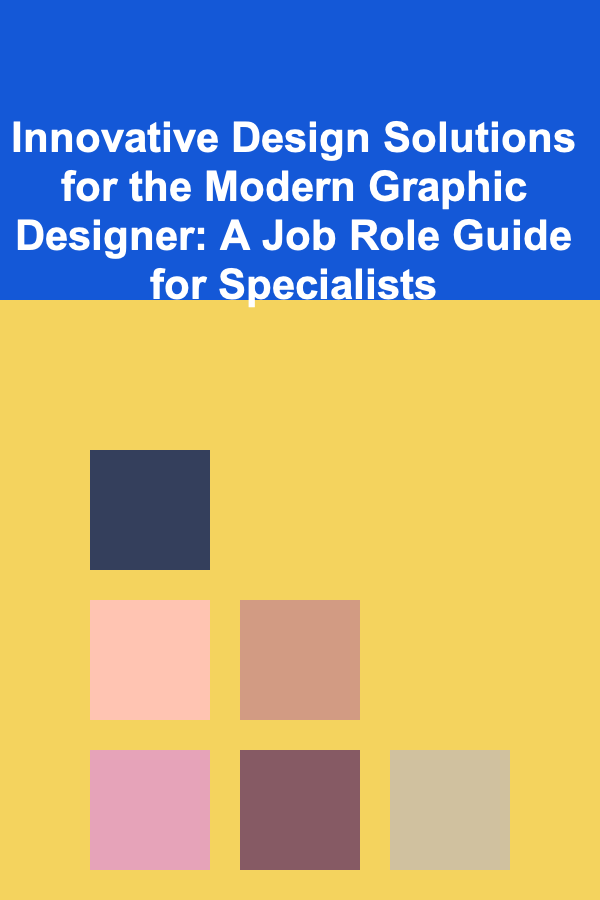
Innovative Design Solutions for the Modern Graphic Designer: A Job Role Guide for Specialists
ebook include PDF & Audio bundle (Micro Guide)
$12.99$10.99
Limited Time Offer! Order within the next:

Graphic design has evolved tremendously over the past few decades. With the rapid advancements in technology, shifts in consumer expectations, and the increasing demand for digital solutions, the role of a modern graphic designer is constantly being reshaped. No longer confined to traditional print materials, graphic designers today are tasked with creating highly dynamic, multifaceted designs for websites, apps, social media, marketing campaigns, and much more.
In this guide, we will explore innovative design solutions that modern graphic designers can leverage. From understanding emerging trends to adopting new technologies, this article aims to help specialists navigate the ever-changing design landscape and provide actionable insights for staying relevant and competitive in the field.
Embracing the Digital Evolution
1.1 Transitioning from Print to Digital
While graphic design began as a print-centric discipline, the advent of the digital age has fundamentally transformed the way designers work. Today, digital platforms such as websites, mobile apps, social media, and e-commerce sites play a dominant role in design projects.
For graphic designers specializing in digital design, staying abreast of technological advances is crucial. A solid understanding of UI/UX design principles , responsive design , and interactive elements is now just as important as mastering typography or layout in print.
- Responsive Design: With an increasing number of users accessing websites on mobile devices, responsive design has become a must. This approach ensures that your design adapts seamlessly to different screen sizes, enhancing the user experience (UX).
- UI/UX Design : The user interface (UI) and user experience (UX) design are essential for creating functional and engaging websites and applications. Familiarity with tools like Sketch , Figma , or Adobe XD is indispensable for creating wireframes, prototypes, and high-fidelity mockups.
- Interactive Elements: Integrating interactivity into designs is becoming standard, especially in web and mobile platforms. Animations, hover effects, and micro-interactions enhance user engagement and offer a more immersive experience.
1.2 Incorporating Augmented Reality (AR) and Virtual Reality (VR)
As technology advances, immersive experiences are becoming a key component of modern design. Augmented reality (AR) and virtual reality (VR) are two technological innovations that are changing the way designers approach creative solutions.
- AR: Augmented reality overlays digital elements onto the real world, often through mobile devices. For example, designers can create AR advertisements or packaging that comes to life when viewed through a smartphone or AR glasses. This technology opens up exciting possibilities for creating interactive and engaging marketing campaigns.
- VR: Virtual reality, on the other hand, immerses the user in a completely virtual environment. For graphic designers, VR presents an opportunity to design 3D environments, virtual product experiences, and even virtual storefronts.
Mastering these technologies can set you apart from the competition and position you as an innovator in your field.
Adopting Cutting-Edge Design Tools and Software
2.1 The Importance of Staying Updated with Design Software
To produce exceptional designs, modern graphic designers need to stay updated with the latest tools and software. Over time, new applications and features emerge, offering enhanced functionality and streamlining the design process.
Key tools to consider:
- Figma: A collaborative design tool that has rapidly gained popularity due to its cloud-based approach, allowing designers to work in real-time with others.
- Adobe Illustrator & Photoshop: While they are traditional favorites, Adobe continues to evolve its offerings. Mastering their new features, such as AI-powered tools and collaborative features, can streamline your design process.
- Canva: For designers looking for quick solutions or creating social media graphics on a tight deadline, Canva is a powerful yet easy-to-use tool that includes templates, stock images, and design elements.
- Procreate: As digital art becomes more widespread, Procreate has become the go-to tool for illustrators and designers wanting to create intricate, hand-drawn elements that add a personal touch to digital designs.
Adopting these tools and keeping your skills current will allow you to produce designs faster, more efficiently, and with greater creative freedom.
2.2 AI-Driven Design: The Future of Design Tools
Artificial intelligence (AI) is starting to reshape the design landscape. Tools that use AI to assist in the design process can dramatically improve productivity, enhance creativity, and open up new possibilities.
For example:
- Design Automation: AI-powered design tools can automate repetitive tasks like resizing images or adjusting layout elements, freeing up more time for creative thinking.
- Smart Composition: AI can assist in creating compositions by analyzing user input and suggesting design adjustments based on design principles.
- Content-Aware Editing: Tools like Adobe Sensei use AI to enhance images and designs by suggesting or automating editing tasks.
While AI will not replace the creativity of designers, it will undoubtedly help them become more efficient and provide new opportunities to push the boundaries of design.
Harnessing Creativity through Emerging Design Trends
3.1 Minimalism and Flat Design
The design world has seen the rise of minimalism, a style characterized by clean lines, simplicity, and a focus on functionality. In graphic design, minimalism involves stripping away unnecessary elements and concentrating on the essentials---clear typography, bold color schemes, and whitespace.
- Flat Design: This is a subset of minimalism that focuses on the use of simple shapes, bold colors, and the absence of 3D elements like shadows or gradients. Flat design is widely used in web and app design because it enhances readability and user experience.
Minimalism is effective because it communicates the message clearly and efficiently, creating a user-friendly experience that avoids overwhelming the audience.
3.2 Custom Illustrations and Typography
Custom illustrations and typography are becoming increasingly popular as a way to differentiate brands and add personality to designs. Rather than relying on generic stock images or standard fonts, more brands are opting for bespoke, hand-drawn elements that speak directly to their identity.
- Illustrations: Creating unique, original illustrations helps to establish a strong brand presence. Whether it's for a website, social media content, or print materials, custom illustrations can elevate a brand and make it more memorable.
- Typography: Custom fonts and typography also offer a way for designers to create distinct visual identities. Designers are now incorporating hand-lettered fonts, animated typography, and expressive text into their designs to create more engaging content.
These trends allow for more personalization and help brands stand out in an increasingly crowded digital space.
3.3 Dark Mode and Neomorphism
With the rise of dark mode in user interfaces, designers are adapting their design styles to provide more visually comfortable, low-light environments. Dark mode has been embraced by popular apps and websites like Instagram, Twitter, and YouTube due to its sleek aesthetic and the fact that it reduces eye strain.
Additionally, neomorphism, a new design trend that combines flat design with subtle depth through soft shadows, has also gained traction. Neomorphism blends skeuomorphism and flat design to create interfaces with a "soft" 3D look, giving a more tactile and immersive user experience.
The Role of Collaboration in Modern Design
4.1 Working with Cross-Disciplinary Teams
Graphic design today is a collaborative effort. Designers rarely work in isolation and often have to communicate and collaborate with other specialists such as developers , marketers , product managers , and content creators.
- Collaboration Tools : Platforms like Slack , Trello , and Asana help streamline communication and project management. Using these tools effectively ensures that all team members are on the same page and can easily share resources and feedback.
- Multidisciplinary Skillsets: As the lines between different disciplines blur, designers are now expected to have a working knowledge of fields such as digital marketing, product design, and even coding. This broader skill set allows for smoother collaboration and a deeper understanding of how design fits into the larger business or product strategy.
By working well within a team, designers can contribute their expertise while learning from others, producing higher-quality results.
4.2 Understanding the Business Aspect of Design
Modern designers need to think beyond aesthetics and focus on how their work drives business results. Whether you're working on branding, a website, or an advertising campaign, understanding how design affects a company's bottom line is essential.
- Design Strategy: Designers should align their work with the overarching business goals. Whether it's increasing conversion rates through a website redesign or creating brand assets that build loyalty, design should always be purposeful and aligned with the business's objectives.
- Analytics : An understanding of analytics and how to measure the effectiveness of design is essential. Tools like Google Analytics and heatmaps help designers see how their work performs in the real world, allowing them to make data-driven design decisions.
Being able to quantify the impact of your design choices enhances your value as a designer and demonstrates your ability to deliver tangible results.
Conclusion
Innovative design solutions are at the heart of modern graphic design. As a designer, staying ahead of trends, mastering new technologies, and continually honing your creative skills are critical to maintaining relevance in the ever-evolving industry. By embracing digital design, adopting cutting-edge tools, and staying collaborative, graphic designers can create meaningful, innovative solutions that captivate audiences and solve complex problems.
The key takeaway is that the modern graphic designer must remain versatile, proactive, and ready to embrace change---only by doing so can they continue to craft designs that resonate in today's fast-paced, digital world.

Creative Thrifty Pantry Organization Ideas to Maximize Your Space
Read More
How to Budget for Major Life Events like Weddings and Children
Read More
How to Optimize Storage in Your Bathroom Without Renovating
Read More
How to Organize Study Materials for Group Projects
Read More
How to Perform Regular Appliance Maintenance to Extend Their Lifespan
Read More
How to Use Leftover Ingredients Creatively in Meal Prep
Read MoreOther Products

Creative Thrifty Pantry Organization Ideas to Maximize Your Space
Read More
How to Budget for Major Life Events like Weddings and Children
Read More
How to Optimize Storage in Your Bathroom Without Renovating
Read More
How to Organize Study Materials for Group Projects
Read More
How to Perform Regular Appliance Maintenance to Extend Their Lifespan
Read More